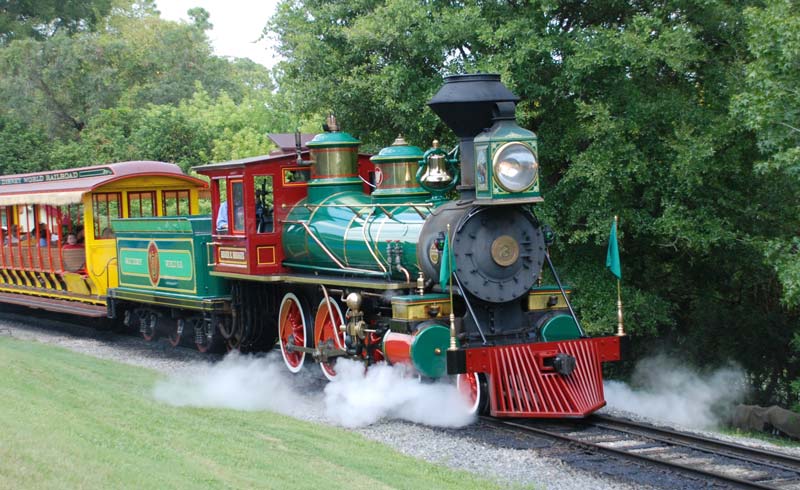Disney World Railroad
The Walt Disney World Railroad (WDWRR) has been a part of the Disney experience since the park first opened in 1971 and remains one of the busiest attractions – welcoming nearly 3.7 million riders a year. The 1.5 mile round trip tour takes about 20 minutes to complete and is a great way to relax, see the sights of Disney World, or just leisurely get from one point in the park to another. Let’s take a look at how one of the park’s biggest attractions came to be.

Walt Disney LOVED Trains
Walt Disney World is often described as ‘the happiest place on Earth’. When designing the theme parks, Walt Disney often looked to incorporate things that brought him joy. Disney had a well known love for trains and even constructed a 1/8th-scale model railroad in his backyard.
After the success of the Disneyland Railroad steam locomotive attraction at his California theme park, Disney wanted a similar attraction for Walt Disney World in Florida. Although Disney passed away during the planning and development stages of WDW, those involved made sure that his wish was fulfilled and the Walt Disney World Railroad remained a focal point for the park.
Origin of the WDWRR Locomotives
The development of WDWRR was headed by Roger E. Broggie, who was involved with the planning and development of the Disneyland Railroad attraction at Disneyland in California. His previous experience with the Disneyland project taught Broggie a lot, specifically that the company would be better off sourcing existing locomotives versus having their own manufactured. Broggie, using advice given to him by rail historian Gerald M. Best, sourced locomotives from the narrow-gauge railroad system ‘Ferrocarriles Unidos de Yucatan’ in Mexico.

The narrow gauge system was 3 ft. or 914 mm, similar to the Disney World Railroad. Broggie acquired 4 locomotives that could be renovated as well as a fifth one that was not operational. Alteration of the locomotives was done to give them a resemblance to the 1880s trains and return them to working condition. Passenger cars for the locomotives were custom-made from the ground up.
Restoring the Locomotives for the WDWRR
The locomotives and their spare parts were sent to the Tampa Ship Repair & Dry Dock Company in Florida, where necessary restorations were made. The project was handled by Transportation Superintendent Earl Vilmer, Project Engineer Bob Hapur, and Machinist Supervisor George Britton.
The restoration was done to match the 1880s train appearance, with the damaged BLW boilers being replaced with smaller Dixon Boiler Works’ versions. Steel and wood cabs were replaced with fiberglass ones, and new tenders were installed. The refurbishment of domes, brass bells, wheels, and side rods allowed them to be retained. The modification of the fireboxes allowed the locomotives to use diesel oil, and builder plates copies were made in place of the originals.
One locomotive from PLCW, constructed in 1902, was the oldest of the five and could not be restored due to too many mechanical issues. Some of its parts, like the smokestack, were used to restore the remaining BLW locomotives. It was stored in California and later sold to a broker.

The Locomotives
WDWRR Opens and Expands
In early 1971, the Magic Kingdom received its first completed locomotive and five passenger car set. The railroad was the first attraction to be fully finished for the theme park which opened in October of that year.
When the attraction first opened, the only station available to the public when the attraction opened was the Main Street USA station, which was designed using the same Victorian style as the Saratoga Springs Station in Saratoga Springs, New York. In 1972, the last change made before Broggie’s 1973 retirement was the opening of the first Frontier Station on the park’s west-side edge within the Frontierland section. The Auto-Train Corporation sponsored the railway between 1976 and 1977.
In 1988, Mickey’s Birthdayland Station was opened within the newly constructed Mickey’s Birthdayland, and the railroad was temporarily renamed Mickey’s Birthdayland Express. It was located near the Fantasyland section, and In 2004 the station was completely rebuilt.

In 1990, the Frontierland section was taken down and replaced with the Splash Mountain attraction. In 1991, the present Frontierland Station was opened after construction a bit north of the original site. Between 1990 and 1991, Backtrack Express was the temporary name given to WDWRR while operating a single train. The train traveled between Main Street USA and the Mickey’s Starland sections.
The current Fantasyland Station was opened in 2012, on the site where Mickey’s Toontown Fair Station was. In the same year, maintenance buildings and the water tower near Fantasyland Station were changed to match the station’s design.
WDWRR Today
The Walt Disney World Railroad remains one of the most popular attractions at Disney World even 50 years after making its debut. As of posting, the railroad has three stations/stops which can be found in Main Street, USA, Frontierland, and Storybook Circus at Fantasyland. The park does not run every locomotive each day; so be sure to check with park staff at the stations to see which locomotive will lead your train.

A fan of big machines and writing. Now I can enjoy both passions.
